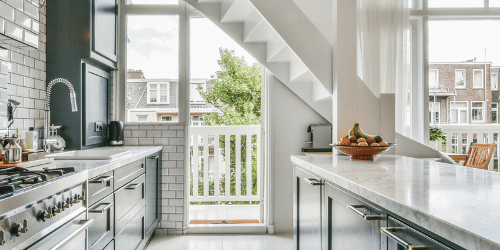Embarking on a kitchen remodel is an exciting yet daunting task. Proper preparation can make the process smoother and more enjoyable. This blog post will guide you through essential steps to prepare your home for a kitchen remodel, ensuring a successful transformation.
Proper preparation is crucial for a successful kitchen remodel. By decluttering, setting up a temporary kitchen, and planning for the unexpected, you can minimize disruptions and ensure a smooth renovation process.
Decluttering and Organizing
Clearing Out Cabinets and Drawers
Remove all items from cabinets and drawers to clear out the space and prepare for any necessary changes or updates. Sort the items into categories: keep, donate, and discard, making decisions about what to retain, give away, or throw away. Once the cabinets and drawers are empty, clean and sanitize the spaces thoroughly to remove any dust, grime, or residue, ensuring a fresh and clean environment before you reorganize or restock. This process not only helps in decluttering but also prepares the area for any remodeling work.
Organizing Essentials
Keep frequently used items easily accessible by placing them in convenient, readily available locations to ensure smooth operation during your remodel. Store seasonal or rarely used items in less accessible areas or in another part of the house to keep your space organized and functional. Label all boxes clearly for easy identification, making it simpler to find what you need without having to open multiple containers. This approach helps maintain order and efficiency while your home undergoes changes.
Creating Storage Solutions
Use bins and baskets to effectively organize and categorize items, making them easy to access and manage during your remodel. Consider adding temporary shelving units to create additional storage space and keep your belongings systematically arranged. Take advantage of underutilized spaces, such as the tops of cabinets, closet corners, or even behind doors, to optimize storage and reduce clutter. By employing these strategies, you can maintain an organized and functional environment, ensuring that your home remains efficient and comfortable throughout the remodeling process.
Setting Up a Temporary Kitchen
Choosing a Location
Select a convenient and spacious area for your temporary kitchen setup to ensure ease of use and functionality. Make sure the space has access to essential utilities, including water and electricity, to support cooking and cleaning activities. Additionally, consider the proximity of the temporary kitchen to dining areas to streamline meal service and minimize the effort required to transport food. By carefully choosing the location and ensuring it meets these practical needs, you can maintain efficiency and comfort throughout your remodeling project.
Essential Appliances and Tools
Set up a microwave, toaster oven, and hot plate in your temporary kitchen to cover basic cooking needs and offer convenience for meal preparation. Keep essential utensils and cookware within easy reach to ensure that you can cook and serve meals without hassle. To minimize dishwashing, use disposable plates and cutlery, which simplify cleanup and help manage the limited resources of your temporary setup. These practical steps will help you maintain a functional and efficient kitchen during your remodeling project.
Meal Planning and Preparation
Plan simple, no-cook meals that require minimal preparation, such as salads, sandwiches, and ready-to-eat snacks, to make mealtime easy and stress-free. Prepare and freeze meals in advance, allowing you to quickly reheat and enjoy dishes without extensive cooking during the remodel. Utilize outdoor grilling as an alternative cooking method, taking advantage of the grill for everything from burgers to vegetables, and reducing the reliance on indoor appliances. These strategies will help you manage meals efficiently and comfortably while your kitchen is undergoing renovation.
Protecting Your Home
Dust and Debris Control
Seal off the kitchen area with plastic sheeting to contain dust and debris, preventing it from spreading to other parts of your home. Use drop cloths to protect floors and furniture, ensuring they remain clean and undamaged during the remodeling process. Regularly clean and vacuum the work area to minimize dust and maintain a tidy environment, which contributes to a more efficient and less stressful project. Taking these precautions helps preserve the rest of your home and keeps the remodeling space organized.
Managing Noise and Disruptions
Inform neighbors about the remodel schedule well in advance, providing them with specific dates and times when noisy activities will occur. This courtesy helps them prepare and reduces potential frustrations. Plan noisy tasks during daytime hours to minimize disturbances, ensuring that activities such as drilling and hammering are carried out at times that are less likely to disrupt neighbors’ daily routines and sleep. Additionally, use white noise machines or soundproof barriers to mask construction sounds, creating a quieter and more comfortable environment for both your household and the surrounding community. These proactive measures help maintain a peaceful neighborhood atmosphere, foster good relations with neighbors, and make the remodeling process smoother for everyone involved.
Ensuring Safety
Keep children and pets away from the work area to ensure their safety and prevent any accidental injuries. Secure tools and materials when not in use by storing them in a locked container or designated area, reducing the risk of mishandling or accidents. Install temporary barriers, such as safety gates or fencing, to clearly define the construction zone and prevent unauthorized access. These precautions help create a safer environment during the remodeling process, protecting both your family and the workers on-site.
Planning for the Unexpected
Budgeting for Contingencies
Set aside a contingency fund to cover unexpected expenses that may arise during the remodeling process, ensuring you are prepared for any surprises. Track all expenses meticulously, using detailed records to monitor spending and adjust the budget as needed to accommodate any changes or unforeseen costs. This will help you stay on top of your finances and avoid overspending. Prioritize essential tasks and modifications, focusing on the most critical aspects of the project to ensure they are completed first. This helps you stay within budget while achieving the primary goals of the remodel. By having a financial buffer and being diligent with expense tracking, you can manage financial surprises effectively and keep the project on track, ensuring a smooth and successful remodel.
Handling Delays and Changes
Communicate regularly with contractors to stay informed about progress and any potential issues, fostering a collaborative and transparent working relationship. Be flexible with timelines and schedules, understanding that adjustments may be necessary due to unforeseen circumstances. Have a backup plan for essential tasks to ensure continuity and avoid delays, enabling the project to proceed smoothly even when unexpected challenges arise. By maintaining open communication, adapting to changes, and preparing for contingencies, you can navigate the remodeling process more effectively and achieve your desired outcomes.
Staying Positive and Patient
Focus on the end result and the benefits of the remodel, keeping in mind how the improvements will enhance your living space and quality of life. Take breaks and practice self-care to avoid burnout, ensuring you stay refreshed and motivated throughout the project. Celebrate small milestones along the way, recognizing the progress made and maintaining a positive outlook. This approach helps keep you grounded and focused, making the remodeling journey more enjoyable and rewarding.
Answering Common Questions
Q1 How long does a kitchen remodel typically take?
A1 kitchen remodel can take anywhere from a few weeks to several months, depending on the scope of the project and any unforeseen delays.
Q2 What should I do with my pets during the remodel?
A2 It’s best to keep pets away from the construction area. Consider boarding them or setting up a safe space in another part of the house.
Q3 How can I minimize the mess during the remodel?
A3 Use plastic sheeting to seal off the kitchen, cover floors and furniture with drop cloths, and clean regularly to keep dust and debris under control.
The Impact of Proper Planning
Proper planning can significantly reduce stress and ensure a smoother remodeling process. By anticipating challenges and preparing accordingly, you can avoid common pitfalls and enjoy a more efficient renovation.
Seeking Expert Advice
For a successful kitchen remodel, consider seeking advice from professionals. Contractors, designers, and remodelers can provide valuable insights and help you navigate the complexities of the project.
Conclusion
Preparing your home for a kitchen remodel is a crucial step in ensuring a smooth and successful renovation. By decluttering, setting up a temporary kitchen, protecting your home, and planning for the unexpected, you can minimize disruptions and stress. Remember to budget for contingencies, communicate effectively with contractors, and stay positive throughout the process. With proper preparation and a clear plan, your dream kitchen will soon become a reality.
Visit us at Pristine Luxury Remodeling
For more information and personalized guidance visit us at Pristine Luxury Remodeling, We specialize in providing exceptional remodeling services that elevate your space into a masterpiece of luxury.







